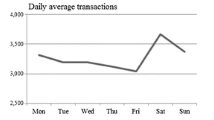Abstract
In many service organizations, rosters must be constructed weekly or monthly as demand and available personnel change. Once the permanent workforce is fixed, it may not be possible to alter its composition easily, implying that expensive contract labor may be the only option to cover shortages. With respect to nursing resources, this means calling in part-timers, casuals, or agency nurses on a daily basis, or hiring travelers for up to several months at a time.
This paper addresses the latter option and presents two models that can be used to solve what we call the nurse addition problem. The first was originally developed to solve the midterm preference scheduling problem and is based on a pattern-view formulation. The second is derived from a shift-view formulation and is solved with a branch-and-price algorithm. In either case, the objective is to hire up to some predetermined number of nurses and assign them midterm schedules that minimize the maximum amount of uncovered shifts per day in the planning horizon. Each roster selected for a new nurse must satisfy a set of hard constraints related to the total working hours, workstretches, time between shifts, and weekend requirements, and a set of soft constraints related to days-on and days-off patterns and transitions from one shift type to another. Extensive testing with data provided by a 400-bed hospital indicated that most instances could be solved in a matter of minutes.
Similar content being viewed by others
References
Bard JF (2004) Selecting the Appropriate Input Data Set when Configuring a Permanent Workforce. Computers & Industrial Engineering 47(4): 371–389
Bard JF, Morton DP, Wang YM (2006) Workforce Planning at USPS Mail Processing & Distribution Centers Using Stochastic Optimization, to appear in Annals of Operations Research.
Ernst AT, Jiang H, Krishnamoorthy M, Sier D (2004) Staff Scheduling and Rostering: A Review. European Journal of Operational Research 153(1): 3–27
Lin CKY, Lai KF, Hung SL (2000) Development of a Workforce Management System for a Customer Hotline Service. Computers & Operations Research 27(10): 987–1004
Dawid H, Konig J, Strauss C (2001) An Enhanced Rostering Model for Airline Crews. Computers & Operations Research 28(7): 671–688
Misra S, Pinker EJ, Shumsky RA (2004) Salesforce Design with Experience-based Learning. IIE Transactions on Scheduling & Logistics 36(10): 941–952
Molleman E, Slomp J (1999) Functional Flexibility and Team Performance. International Journal of Production Research 37(8): 1837–1858
Kimball B, O'Neil E (2002) The American Nursing Shortage. (The Robert Wood Johnson Foundation, Princeton, NJ)
Spratley E, Johnson A, Sochalski J, Fritz M, Spencer W (2000) The Registered Nurse Population. Findings from the National Sample Survey of Registered Nurses, (U.S. Department of Health and Human Services, Washington, DC). Available at http://www.ruralnursing.org/rnsurvey00-1.pdf
O'Neil E, Seago JA (2002) Meeting the Challenge of Nursing and the Nation's Health. Journal of the American Medical Association 288(16): 2040–2041
Beaulieu H, Ferland JA, Bernard G, Michelon PA (2000) Mathematical Programming Approach for Scheduling Physicians in the Emergency Room. Health Care Management Science 3: 193–200
Bechtold SE, Jacobs LW (1996) The Equivalence of General Set-Covering and Implicit Integer Programming Formulations for Shift Scheduling. Naval Research Logistics 43(2): 233–249
Burns RN, Carter MW (1985) Work Force Size and Single Shift Schedules with Variable Demands, Management Science 31(5): 599–607
Brusco MJ (1998) Solving Personnel Tour Scheduling Problems Using the Dual All-Integer Cutting Plane. IIE Transactions on Operations Engineering 30(9): 835–844
Burke EK, Causmaecker PD, Vanden Berghe G, Van Landeghem H (2004) The State of the Art of Nurse Rostering. Journal of Scheduling 7(6): 441–499
Cheang B, Li H, Lim A, Rodrigues B (2003) Nurse Rostering Problems – A Bibliographic Survey. European Journal of Operational Research 151(1): 447–460
Bard JF, Purnomo HW (2005) Preference Scheduling for Nurses Using Column Generation. European Journal of Operational Research 164(2): 510–534
Millar H, Kiragu M (1998) Cyclic and Non-cyclic Scheduling of 12-Hour Shift Nurses by Network Programming. European Journal of Operational Research, 104: 582–592
Jaumard B, Semet F, Vovor T (1998) A Generalized Linear Programming Model for Nurse Scheduling. European Journal of Operational Research 107: 1–18
Emmons H (1985) Work-force Scheduling with Cyclic Requirements and Constraints on Days Off, Weekends Off, and Work Stretch. IIE Transactions 17(1): 8–15
Bard JF, Purnomo HW (2005) Short-Term Nurse Scheduling in Response to Daily Fluctuations in Supply and Demand. Health Care Management Science, 8(4): 315–324
Warner DM (1976) Scheduling Nursing Personnel According to Nursing Preference: A Mathematical Programming Approach. Operations Research 24(5): 842–856
Purnomo HW, Bard JF (2005) Cyclic Preference Scheduling For Nurses Using Branch and Price, Working paper, (Graduate Program in Operations Research & Industrial Engineering. The University of Texas, Austin)
Garey MR, Johnson DS (1979) Computers and Intractability: A Guide to the Theory of NP-Completeness. (W.H. Freeman: New York)
Author information
Authors and Affiliations
Corresponding author
Additional information
This work was supported in part by the National Science Foundation under grant DMI-0218701.
Rights and permissions
About this article
Cite this article
Bard, J.F., Purnomo, H.W. Incremental changes in the workforce to accommodate changes in demand. Health Care Manage Sci 9, 71–85 (2006). https://doi.org/10.1007/s10729-006-6281-y
Received:
Accepted:
Issue Date:
DOI: https://doi.org/10.1007/s10729-006-6281-y




